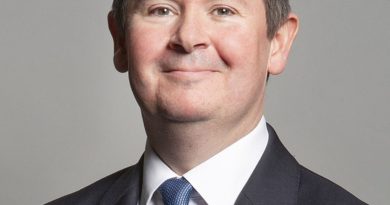Adam Holloway – 2022 Speech on the Lower Thames Crossing
The speech made by Adam Holloway, the Conservative MP for Gravesham, in the House of Commons on 24 March 2022.
Mr Deputy Speaker, perhaps you will pass on my thanks to Mr Speaker for granting this important debate. I welcome the Under-Secretary of State for Transport, the hon. Member for Copeland (Trudy Harrison), to her place, although I am sorry that the roads Minister is a Member of the other place and cannot reply.
There is truly an opportunity for us to save billions of pounds that we are about to spend, unnecessarily in my view, on a new crossing of the Thames to the east of the current one at Dartford, to the east of Gravesend. The original idea behind having another crossing of the Thames was to ease the appalling congestion at Dartford. There cannot be anybody watching the debate or in the Chamber who has not sat for hours and hours trying to cross the Thames at Dartford. As is the way of Government, there have been endless studies and consultations on the best way to stop this awful gridlock on the M25. For years, Ministers have told me privately that the solution is to build another bridge at Dartford to ease the pressure caused by the inadequate north-bound tunnels. After all, the M25 runs through Dartford—it always has and it always will.
There is a huge problem that needs fixing, and that is how the traffic gets past the River Thames at Dartford and through Thurrock. During the course of those years of study, other options were explored—one would expect that—including a crossing some miles further down the river to the east of Gravesend. When Kent and Essex County Councils realised that a crossing further down the Thames from Dartford was in the offing, they made sure that the consideration was turbocharged, seeing massive economic benefits to both counties if they had a link road between them—that is understandable. So, slowly, the project morphed from one about how to fix the traffic at Dartford to one about economic development for Kent and Essex, with, to them, the secondary consideration that this economic development tunnel and new road network would also have the effect of reducing some of the pressure at Dartford, and also providing resilience.
Jackie Doyle-Price (Thurrock) (Con)
Will my hon. Friend give way?
Adam Holloway
Yes, of course, I will give way. I did mention my hon. Friend’s constituency.
Jackie Doyle-Price
I do not disagree with my hon. Friend’s analysis of how we ended up with this route, but does he agree that it is all very well for Kent and Essex to draw a line as to where that road should go when it actually goes through Thurrock, to which they are not accountable? If they were really genuinely interested in supporting it, they should work towards the optimum route.
Adam Holloway
That is an extremely good point, and I wish that I had included it in my speech. If I have to speak about this again, I will make that point. I thank my hon. Friend and I totally agree with her.
This all became about economic development. The original purpose of easing traffic became secondary. The aims of the project changed completely, which meant that the problems at Dartford were no longer the priority—in fact, they became a secondary consideration. Then, my right hon. Friend the Member for Epsom and Ewell (Chris Grayling), the then Transport Secretary, opted for Kent and Essex’s preferred option, which will do nothing to ameliorate the situation at Dartford and will be yet another massive piece of Government spending on road infrastructure just at the moment in our history when roads are to be optimised by level 5 autonomous vehicles. The way I think of it is that if we look across the rooftops of London we see thousands of chimneys, none of them used any more. This road will end up a white elephant like them in future—and not far in the future.
First, the lower Thames crossing does not address the problems on the M25 at the Dartford crossing or provide any resilience in any way, shape or form. I will explain why. The M25 northbound at Dartford remains one of Europe’s worst traffic jams on a major national road—I imagine all hon. Members, even the Minister, can picture themselves there, having sat in those traffic jams.
The problems at the Dartford crossing are primarily caused by the outdated and undersized northbound tunnels. The southbound traffic coming over the bridge moves at pretty much the same speed as the rest of the motorway; it is not immune to traffic jams, but neither is the rest of the system. The problem is the tunnels. The left-hand one is 4.8 metres high and the right-hand one is 5 metres high. They are the cause of the horrendous jams, because no fuel tankers or hazardous loads are permitted unescorted, and no vehicles over 5 metres high are permitted at all.
What happens is that we end up with traffic, including very large vehicles, weaving and causing frequent accidents and incidents, as well as frequent red traffic lights to hold the rest of the traffic in order to extract an over-height vehicle that has managed to go through. Then, of course, a couple of times an hour all the traffic on the M25 going north is stopped, because they have to run the convoys with fuel tankers and hazardous materials in them. That causes congestion and queuing, and hardly a day goes by without a major incident bringing the M25 to a complete standstill and causing gridlock at Dartford.
The lower Thames crossing, the one to the east of Gravesend, does not address those problems at all, nor does it provide a satisfactory alternate route for M25 traffic. Let us note, by the way, that the M25 is not complete—it stops just before Dartford and becomes an A road, and then becomes the M25 again. We have not actually finished building the M25 yet.
Once the lower Thames crossing is built, the Dartford crossing will still be operating at capacity and the problems there will continue. The long-suffering residents and businesses of Dartford will continue to suffer, and I believe they are being hoodwinked. We must sort out the problem of Dartford first and foremost, either with the originally promised relatively cheap and cheerful bridge for northbound traffic, or with a variant of option A14, which is the idea to have a big tunnel going underneath Dartford and Thurrock, separating all the national, long-range traffic, so the existing crossings could be used by residents of Dartford, Thurrock and so on.
Secondly, we have been assured that having a completely different crossing will provide resilience, so what will happen when the incidents continue to happen on the northbound bit of the Dartford tunnel approaches? As soon as traffic on the M25 comes to a standstill, it will seek an alternate route to the lower Thames crossing, but to exit the M25 at junction 2, the junction just before, it will have to go through a traffic light-controlled roundabout, which will be totally inadequate for the volume of traffic.
Having negotiated that obstacle, traffic will head east towards Gravesend only to find that, unbelievably, there will be just one lane from the A2 to the lower Thames crossing tunnel to take traffic into Essex. Not only will Dartford be gridlocked, but so will Gravesend and the whole of the A2 eastbound from M25 junction 2.
Jackie Doyle-Price
My hon. Friend is being very generous in giving way, and he is now getting to the nub of the problems with the design of the lower Thames crossing. It is being applied as a piece of national infrastructure without sufficient thought to the impact on the local road networks in his constituency and mine and that of my hon. Friend the Member for South Basildon and East Thurrock (Stephen Metcalfe). He highlights the lack of connectivity beautifully. For my residents in South Ockendon, if we have a tailback going south and the traffic backs up, not only do they face congestion at the Dartford crossing, but the lower Thames crossing arrives at Ockendon, so residents there will be subject to congestion from both crossings.
Adam Holloway
Absolutely. In a sense, my hon. Friend’s residents and those over in Essex are having it very badly with all the additional roads to be built as well, so I completely concur. We have established that when Dartford is gridlocked, so will Gravesend be, and her area at Ockendon.
With junction 2 of the M25 blocked, the M25 traffic will seek an alternative route to the lower Thames crossing. We will then find that the A227, and all the villages and lanes approaching the new crossing, will become choked with traffic. Just to be clear, although the project is terminal for my hamlet of Thong and terrible for the people of much of Riverview Park and the villages that will become rat-runs, the worst will be for the residents of Dartford—more on that later.
Of course it is absolutely correct that the new crossing will provide a useful alternative for traffic heading to and from the ferry port of Dover, but that is all. Channel tunnel traffic will still try to use the M20 and the M25 and so will still use the Dartford crossing. There is more. National Highways is busy planning another kick in the teeth to motorists once the new crossing is built. In its wisdom, it intends to split the A2 and M2 into two separate two-lane highways midway between the A227 and Marling Cross. The outer two lanes will be for M2 traffic going down deeper into Kent; the inner two lanes will be for the A2 to Strood and the lower Thames crossing, and the Hoo peninsula. That is a recipe for disaster. Not only will it cause dangerous weaving and accidents while the traffic tries to get into the correct lane, but the A2 will be narrowed to two lanes, which is completely inadequate for traffic heading towards the M2 at peak periods. It is ridiculous. In 2009, Highways England actually widened the A2 at this point from three lanes to four lanes to cope with increased volumes, and now the proposal is to narrow it to two lanes.
Let me return to the contention of Kent and Essex County Councils that this crossing would bring large economic benefits. The cost of the project for central Government has increased from £3.72 billion in 2016 to £8.2 billion now. We make these throwaway comments about billions, but imagine having a stack of a million £1 coins and then creating 8,200 stacks of £1 coins. That is an enormous amount of money, and because the project is no longer being privately funded, it is taxpayers’ money. We have a cost of living crisis. Every time people go into a garage or a shop, or pay their income tax, the money for this white elephant is coming off them. It is a financial turkey right now and truly it will be a transport white elephant in a decade—and it will inevitably end up costing more.
The cost-benefit analysis carried out in 2016 had mysteriously changed from the analysis carried out in 2013 to show a benefit of the lower Thames crossing of 2.4. But in 2013, the cost-benefit analysis supported the Dartford option and was against a crossing east of Gravesend, which then apparently provided a benefit of 1.1. Somewhere along the way the figures magically changed to suit the argument. Anyway, at a new cost of £8 billion, any benefit must now be marginal at best. I can completely understand why that might not matter too much to Kent and Essex County Councils, because it is not money from their budgets, but it is the money of hundreds of millions of people who will remain sitting snarled in their cars in traffic jams at Dartford over the coming decades. Far from a new crossing away from Dartford being a victory for the people of Dartford, they are now condemned to decades more noise and pollution. An intergenerational chance to sort out the M25 has been blown by muddled thinking and a political class in local government thinking only of their own political lifetimes. Now would seem to be an appropriate time to carry out an in-depth review to determine whether to proceed with the lower Thames crossing or to go back to the drawing board, sort out the M25 at Dartford and relieve the taxpayer of accruing yet more unnecessary debt for their children and great-grandchildren to repay.
The crossing will not prevent the delays, incidents and gridlock at Dartford, and it will not provide an alternate route for M25 traffic. It is a massive missed opportunity for the people of Dartford, who will have to endure more decades of misery until finally either the northbound bridge or the long tunnel under Dartford and Thurrock is built—one or the other will have to be built eventually. Indeed, I believe that the current tunnels are close to the end of their design life, so why are we building a white elephant further down?
The crossing is far too expensive at £8.2 billion and does not represent value for money for taxpayers. As we have discussed and I have outlined, better, less expensive solutions are available. I urge the Minister to think it through herself and stop listening to Highways England before it is too late and we commit all that money unnecessarily. If there were ever an opportunity for a Secretary of State to put a red line through a massive piece of spending, this is it.



